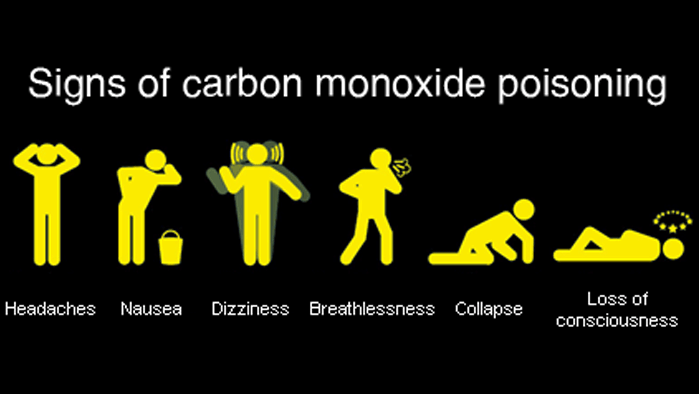Carbon monoxide gas (CO2) is odorless, colorless and tasteless, and an undiscovered carbon monoxide leak can be a stealthy killer. The initial symptoms of carbon monoxide poisoning can easily be mistaken for a headache, a bout of flu or a seasonal cold, but can quickly lead to death in some cases. Without proper detection measures in place you may be unaware of a deadly leak in your home.
Our bodies do little to protect us from CO2 poisoning, since red blood cells in humans absorb CO2 faster than they absorb oxygen molecules. If enough CO2 is inhaled, carbon monoxide molecules begin to replace oxygen in the bloodstream. When this happens, organs and tissues can be permanently damaged, which can then result in death. If you are sleeping or intoxicated, you may suffer serious effects or die without noticing any symptoms.
If you are awake, symptoms of CO2 poisoning usually begin with a headache or mild tightness in the chest. Other more extreme effects are fatigue, drowsiness, dizziness or nausea. If you have experienced prolonged exposure, vomiting, muscle weakness, shortness of breath, blurred vision or fainting may occur. Angina patients may notice sudden sharp chest pain.
While symptoms vary from one person to the next, some home dwellers are more vulnerable to CO2 poisoning. Unborn babies, for example, are at risk because fetal cells absorb carbon monoxide even more eagerly than adult red blood cells. Young children naturally breathe at a more rapid rate than adults, and therefore risk inhaling more CO2 than their adult counterparts. The elderly have also been shown to be more likely to experience brain damage from CO2 exposure.
Carbon monoxide gas is created by combustion from fuel-burning engines. Any number of items in your home may emit fumes that contain dangerous levels of this silent killer. Appliances such as stoves, cooking ranges, water heaters, furnaces and portable generators can all release CO2 if malfunctioning. Vehicles also release carbon monoxide whenever the engine is running. Smaller sources of combustion like space heaters, wood-burning stoves, fireplaces and even charcoal grills can also be culprits if maintained poorly or used improperly.
Fortunately, prevention is within easy reach for the responsible homeowner. Annual inspection of appliances by a certified technician ensures that your stove, water heater and furnace are operating correctly; sometimes these need to be adjusted or calibrated to restrict emissions. If you smell anything odd from a gas-operated appliance, call an expert immediately; refrigerators in particular can emit an odor when the cooling unit malfunctions, and this could indicate a carbon monoxide leak. If you purchase new gas equipment or appliances, buy products that bear a seal from Underwriters’ Laboratories (UL) or the American Gas Association.
Smaller equipment like space heaters, camp stoves and grills should never be operated indoors. Wood-burning stoves and fireplaces should be cleaned and inspected annually, including blockage-prone chimneys. Other gas-burning units that require ventilation, such as clothes dryers and range tops, should be vented tightly and according to code; proper venting technique requires that vents angle upwards for optimal gas flow, and should never be parallel to the floor. If you patch a vent pipe, use proper materials. Tape, gum or other do-it-yourself methods of patching can cause a deadly CO2 leak in your home.
Outside of your home, never let vehicles idle in garages, even with garage doors open. Carbon monoxide can rapidly build to lethal levels in confined spaces. Properly maintained vehicles should have their exhaust system checked by a mechanic with some regularity. If you have a vehicle with a tailgate, never open the tailgate of a running vehicle without also opening windows or doors.
During power outages, do not use a portable generator in the home, garage or basement or near a window or vent that would allow its emissions into the home. Never use an oven to heat a home, even for a short length of time. Grill outside, especially with charcoal, which always emits CO2. Do not sleep in a room with an unvented gas or kerosene space heater.
While no replacement for prevention, all homes should have a battery-operated carbon monoxide detector. Use care when choosing a detector, however, as these products are not regulated and have been shown to have inconsistent performance. Choose a CO2 detector that carries a UL certification sticker, and change its batteries regularly. Carbon monoxide detectors are not considered to be as reliable as smoke detectors but are a good purchase for safety back-up and peace of mind.
If your CO2 alarm does sound, first remove everyone from the premises, then check for symptoms of carbon monoxide poisoning. If someone is sick, seek medical attention immediately. Ventilate the home by opening doors and windows and turn off all potential sources of carbon monoxide. Have your home inspected by a professional before you deem it safe to re-enter.

